*My posts may contain affiliate links, which means I may receive a small commission, at no cost to you, if you make a purchase through a link! Thank you for supporting my website!*
Last updated on February 28th, 2024 at 11:09 am
Wondering when you can paint vs when you need to replace your interior doors? Well, look no further because I have your answer!
If an interior door has surface damage only (minor dents/scratches – no structural damage), is soundly made, contains no lead-based paint, and the style of door is liked, then the door can be painted to extend its life. Otherwise, it needs to be replaced.
Now that we’ve got the basics out of the way, let’s break into the details further so you can easily decide whether your interior doors need to be replaced or not.
Let’s dive in!
Quick Navigation: Paint Vs Replace Interior Doors
- Is The Interior Door Thin Or Poorly Made?
- Does The Interior Door Have Peeling Paint?
- Is The Interior Door Damaged And Can Be Repaired?
- Is The Interior Door Damaged And Cannot Be Repaired?
- Is The Interior Door Out Of Style?
- Other FAQs About Painting Vs Replacing Interior Doors
- Final Thoughts
One: Is The Interior Door Thin Or Poorly Made?
The first question to ask yourself is whether the door is thin or poorly made.
Some doors are high quality and feel sturdy/heavy to the touch while others feel paper-thin and low quality. As with anything in life, high-quality items are worth saving while low-quality items typically require replacing.
Consider the use of the door:
- If the door will be used in a rental or around children or pets and the door feels paper thin, then it is worth replacing with a more quality door that will last longer
- If the door is in your personal residence and you are okay with the quality of the door, then it is worth painting for now and replacing down the road if it ever does get damaged
Now, if you’re lucky and the door is a high-quality wood, then painting it will help the door last longer. Typically, you can’t buy as high-quality doors as they used to make anymore, so keep interior doors that are made of solid wood if you can.
Solid wood doors muffle noises, are more durable, and are easier to repair than modern hollow core doors.
Also, keep in mind that the average door sold at home improvement stores is hollow in the center. When you knock on it, it feels softer than a solid wood door would feel. So if your current door is hollow, that does not necessarily mean it is low quality.

In one of our rentals, the original hollow core doors were so paper thin, they always seemed to end up with holes in them regardless of the type of tenant we put in. To avoid having to constantly repair or replace these doors, we chose to replace them with a more high-quality hollow core door.
(Plus it saved us a ton of time during the flip because replacing a door is faster than painting a door. We only replaced the doors that had major damage and left the ones that were in good condition.)
(If you own some rental properties and want to learn how to manage them better with less time and headache, check out my other blog, DIY Rental Manager.)
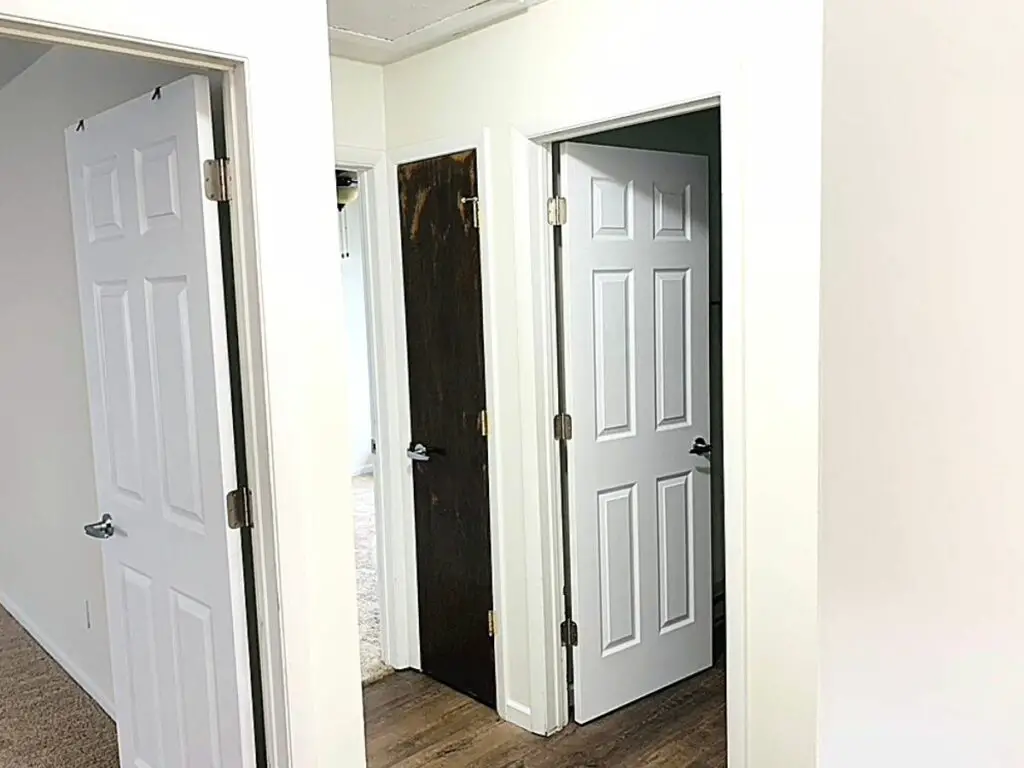
Before you paint any doors, compare the feel of your existing doors to the feel of a reasonably priced interior door at your local hardware store. If the quality feel is similar, then that’s a good sign to paint. However, if the new door feels of higher quality, then that is a sign to replace.
Two: Does The Interior Door Have Peeling Paint?
The next question to ask yourself is whether the door has peeling paint or not.
If the door itself is in good shape (no surface or structural damage), but there is peeling paint, then you can strip the old paint off and repaint the door.
You can strip the old paint either by using Citristrip Paint Stripper found at Amazon or by sanding off the paint. If your door has any detailing, then using the paint stripper will make this job much easier (albeit messier).
A word of caution: Older painted doors can have lead in them which can lead to health problems in children. It’s best to use one of these lead paint test strips found at Amazon before you do anything with the door to confirm there is no lead-based paint on the door (especially if the paint is peeling).
If the door does contain lead-based paint then it’s best to replace the door altogether to avoid any health risks and future problems with the sale of your home. Otherwise, no lead-based paint means it’s safe to remove the peeling paint and repaint the door.
Three: Is The Interior Door Damaged And Can Be Repaired?
The next question to ask yourself is whether the door is damaged and can be repaired.
Some of the areas where your door might be damaged and you can attempt to repair include:
- Dents, holes, scratches
- Sagging
- Damaged door frame (surface level)
Repairing Dents, Holes, Or Scratches In Interior Doors
Oftentimes, small dents and scratches can be filled with Bondo, sanded down, and painted over to look brand new. This repair looks best when your door does not have any wood grain or texture because the Bondo will sand down and be smooth.
If your door does have texture or wood grain, then you could do a skim coat of joint compound over the entire door and sand it to fill the dents and scratches and give the door a smooth finish before painting.
A similar repair technique can be done if there is a hole in the door (such as a hole left behind from a fist) except the hole must be patched with a drywall patch first. Then the door can be skim-coated with joint compound, sanded smooth, and painted over.
Repairing Sagging Interior Doors
If the door is sagging and causing a part of it to rub against the door frame, then the hinges probably just need to be screwed back in. Over time, the screws in the hinges come loose from the door swinging back and forth.
Replacing the existing screws with longer screws can help lift the door back up. Sometimes the screw holes become stripped and the screws have a hard time gripping onto anything anymore.
If this is the case with your door, then you can use this Woodmate Mr. Grip Screw Hole Repair Kit found at Amazon to help give the screws something to grip on again.
Repairing Damaged Door Frames (Surface Level)
If any part of the door frame is damaged and can be filled with Bondo or wood filler, then the door is worth repairing and painting as well.
If there is a large crack in the door frame, then squeezing some wood glue in the crack and clamping it together before using Bondo can help give the frame back its strength.
Ultimately, if the door can be repaired and painted for less than the cost of a new door, then painting is a much more budget-friendly and environmentally-friendly option. However, if the repair and paint will cost more than a new door or if the repair looks like a bad patch job on the door, then replacing the door is a better option.
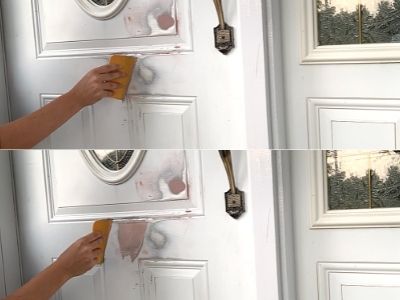
Four: Is The Interior Door Damaged And Cannot Be Repaired?
The next question to ask yourself is whether the door is damaged and cannot be repaired.
Some of the areas where your door might be damaged and beyond repair include:
- Structurally damaged from dents, holes, or burn marks
- Broken door frame (structural)
Structurally Damaged Interior Doors From Dents, Holes, Or Burn Marks
Doors that have any damage that prevents the door from having any structural support (such as holes that make a significant portion of the door cave in) then your only option is to replace the door.
This also includes any burn marks that a door might have from being in or near a house fire. If the door is burned and cannot be repaired, then it must be replaced.
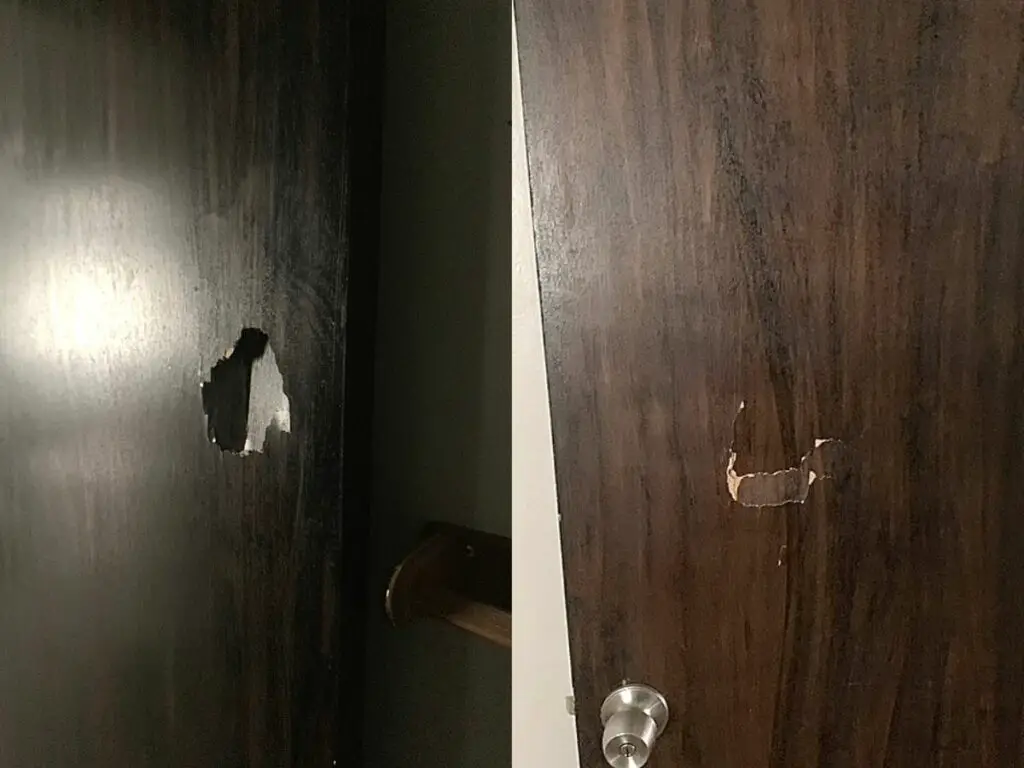
Broken Door Frames (Structural)
Additionally, if any part of the door frame is broken off or missing and it is causing the door to be collapsing/not fully supported, then your best move is to replace the door.
Ultimately, if the door cannot be repaired or cannot be repaired for less money than a new door installed, then replacement is the only way to go.
Five: Is The Interior Door Out Of Style?
The final question to ask yourself is whether the door is in or out of style.
If you can’t stand the style of the door (regardless of the color), then painting it won’t be worth it. In this case, replacing the door will be your best option.
It was common in the 1970s to have flat, wood-colored doors such as these bright orange doors in one of our rentals. Some people add decorative trim to these doors to add dimension before painting them.
However, if you still dislike the look of flat-panel doors even with the faux detailing, then it is probably worth replacing the door.
On the bright side, it is a relatively low cost to paint an interior door. So you can always try painting it and leaving it for a while until you decide if you want to replace it or not.
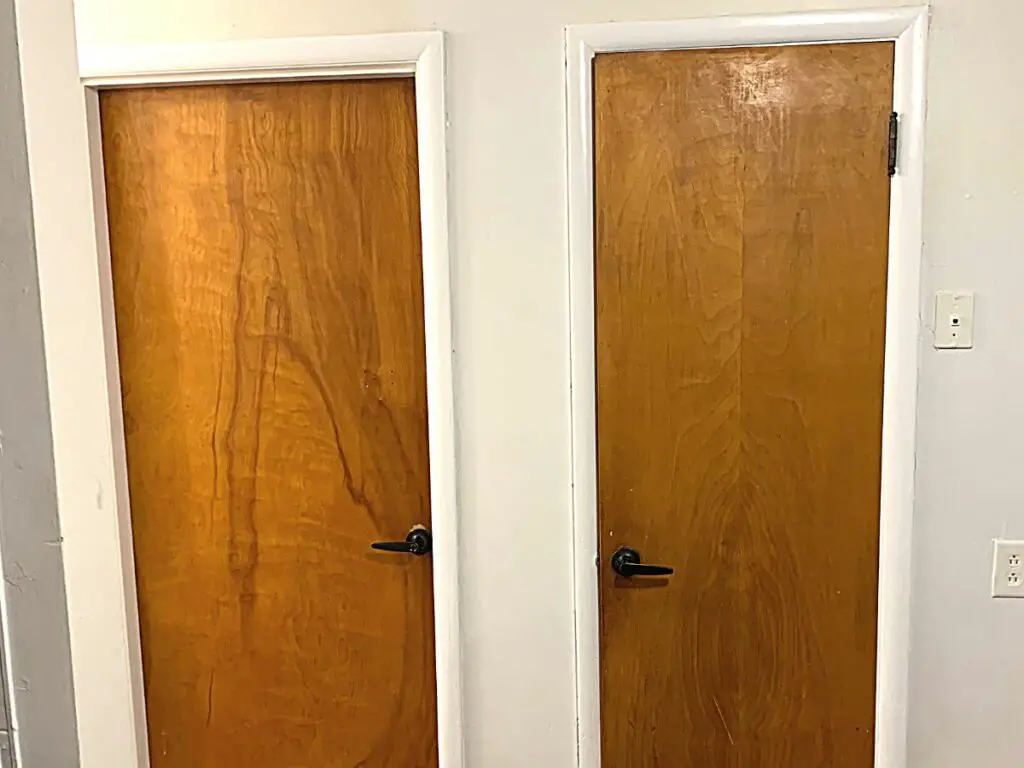
Other FAQs About Painting Vs Replacing Interior Doors
Here are some other frequently asked questions about interior doors to help you more easily decide whether you should paint or replace yours!
Do You Have To Fully Remove Peeling Paint From An Interior Door Before Repainting?
Any peeling paint on an interior door should be stripped off with a paint stripper or sanded down so that none of the original paint is flaking off anymore. Once the original paint layer is removed or smoothed out, a new coat of primer and/or paint can be applied.
Can You Repair A Hole In A Hollow Core Door?
A hole in a hollow core door can be repaired with a drywall hole repair kit. The hole patch is inserted into the hole in the door and repaired with a joint compound. The entire door is then skim-coated with joint compound and sanded down before being repainted.
Can You Fix A Sagging Interior Door?
Sagging interior doors can be fixed by resecuring the stripped screws in the door hinges. To do this, either screw in longer screws into the door hinges or fill in the old hinge holes with dowels and wood glue then re-screw the hinges back in place.
Final Thoughts On Painting Vs Replacing Interior Doors
There you have it!
Asking yourself those questions before you paint anything or start removing anything will help you decide what’s worth your time and money and what’s not.
Hopefully, these points help give you clarity on whether you should paint or replace your interior doors.
Catch you in my next post!
The Best Paint Supplies I’ve Used
Wooster Shortcut Angle Sash Paintbrush (2-Inch)
This is my all-time favorite paintbrush because it is so lightweight! The short handle takes the pressure off your wrist and creates an extremely comfortable grip, so you can paint longer without feeling the weight on your wrist. I use this paintbrush on 99% of my paint projects. You can find this paintbrush here on Amazon.
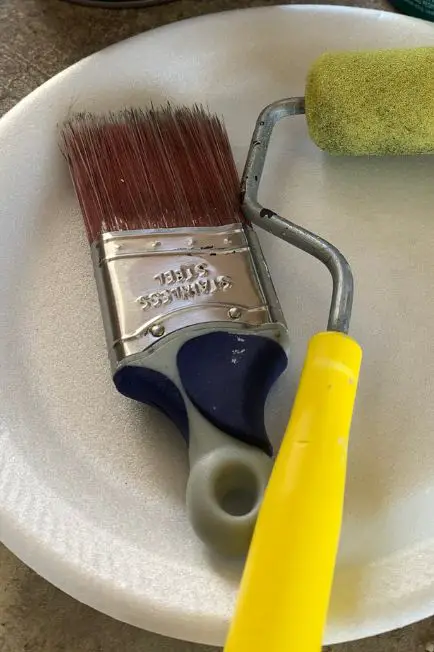
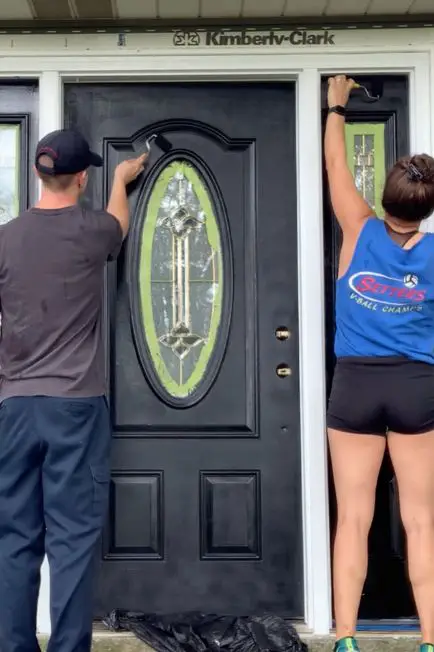
FoamPRO 164 Fine Finish Roller (4-Inch)
If you want the least amount of paint texture left from a roller (such as on metal or furniture), then this is the best roller you can use. The fine finish in the foam leaves the tiniest bit of texture that can easily be sanded between coats to get a finish almost as good as a sprayed finish. You can find this awesome foam roller here on Amazon.
If you’ve been curious about how we are decorating our 1950s Ranch, you should check out our “Shop Our Home” page. You can find products that we’ve personally bought to decorate our home.
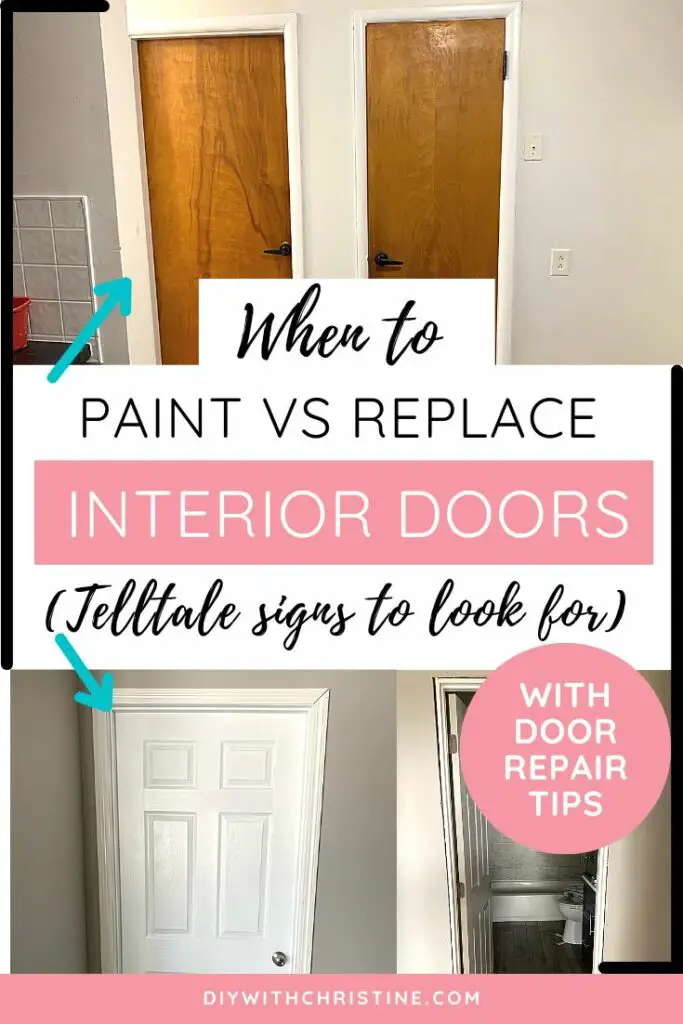

By Christine
Christine is a blogger and DIYer who tackles home renovation and decorating projects alongside her husband, Adam, for their personal residence and rental properties. Although she successfully tackles large renovation projects to avoid expensive contractor fees and bring her vision to life now, her path to success was not easy.
Go here to read her story, “From a Clueless First-Time Homebuyer To A Confident DIYer Creating Her Dream Home One Project At A Time“.
Popular Posts
DIY With Christine is a participant in the Amazon Services LLC Associates Program, an affiliate advertising program designed to provide a means for sites to earn advertising fees by advertising and linking to Amazon.com.






